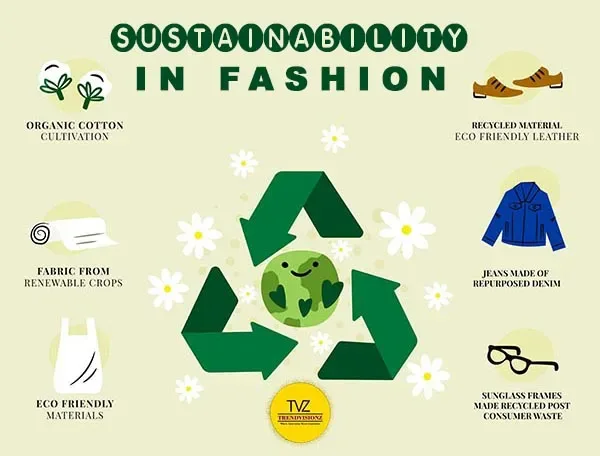Cape Town Sustainable Fashion Designers Leading the Environment-friendly Motion
Cape Town Sustainable Fashion Designers Leading the Environment-friendly Motion
Blog Article
Remain Ahead of the Curve by Checking Out Ingenious Style Fads
In a sector as dynamic as fashion, remaining ahead entails even more than simply adhering to current trends-- it demands an exploration of advancement. The convergence of innovation and fashion advertises a new age of customer engagement.

Embracing Smart Textiles
Over the last few years, the garment industry has actually witnessed a transformative change with the assimilation of smart textiles, an advanced development that mixes innovation with material. This advancement stands for not just a fusion of appearances and capability yet additionally a significant leap in the direction of sustainability and customization in fashion. Smart textiles, likewise called e-textiles, installed innovative electronic devices such as sensing units and conductive strings within the textile, allowing garments to communicate with the wearer or the environment.
These textiles are made to monitor physiological criteria, such as heart rate or body temperature level, supplying real-time wellness analytics. Beyond health applications, smart fabrics are likewise being used for adaptive clothing, which can alter shade or pattern in reaction to ecological stimuli, therefore using a vibrant fashion experience.
In addition, the advancement of energy-harvesting fabrics that create power from movement or sunlight is leading the way for self-sufficient wearable innovation. This technology is attracting environmentally aware consumers and developers aiming to decrease the environmental footprint of style. As r & d in this area advancement, clever fabrics are anticipated to end up being significantly common, reshaping the landscape of contemporary fashion with their multifunctional capacities.
The Rise of 3D Printing
Transforming the production landscape, 3D printing has actually arised as a game-changer in the apparel industry. This sophisticated modern technology has enabled designers to push the boundaries of creativity, generating intricate and customized garments that were formerly unthinkable. By leveraging electronic layout and additive production, 3D printing promotes the creation of intricate geometries and patterns, enabling designers to experiment with brand-new appearances and structures.
A remarkable advantage of 3D printing in fashion is its capacity to generate on-demand, reducing waste and minimizing inventory requirements. This performance not just optimizes production procedures however also enables rapid prototyping, enabling developers to bring their visions to life in a shorter duration. Additionally, 3D printing supports modification to a degree unrivaled by conventional approaches, offering customized fits and special layouts customized to specific consumer preferences.
The surge of 3D printing has actually likewise equalized fashion, making it obtainable to emerging designers that can currently produce high-grade pieces without substantial economic investment in typical production facilities. As innovation continues to development, the style industry is poised to harness the complete possibility of 3D printing, exploring brand-new products and strategies that will certainly redefine how fashion is conceived and created.
Lasting Style Advancements
As the garment industry faces journalism demand for ecological responsibility, sustainable style developments have emerged at the leading edge of transformative change. The expanding recognition of eco-friendly effect has fueled a shift in the direction of even more eco-conscious practices and products. Brand names and developers are currently focusing on sustainability, including methods that minimize waste and reduce carbon footprints.
One substantial advancement is the rise of round fashion, which stresses recycling and upcycling to expand the lifecycle of garments. This method not only lowers waste yet additionally encourages customers to embrace a more mindful technique to clothes usage. Additionally, making use of lasting materials, such as natural cotton, hemp, and recycled polyester, has actually gained grip. These materials call for much less water and energy throughout production, considerably reducing environmental impact.
One more innovation exists in the fostering of ingenious dyeing techniques that make use of waterless useful site processes or all-natural dyes, thereby decreasing the large amounts of water and chemicals traditionally utilized in textile dyeing. In addition, advancements in biotechnology have led to the creation of lab-grown natural leather and materials, offering cruelty-free and eco-friendly choices to conventional products. Through these pioneering efforts, the fashion business is making purposeful strides in the direction of a much more lasting future.

Tech-Integrated Garments
Tech-integrated garments stands for an innovative blend of style and technology, improving exactly how people communicate with their apparel. This innovative domain name is noted by the inclusion of smart fabrics and ingrained electronic elements, improving both performance and visual charm. From fitness trackers embedded in sports apparel to heated coats controlled by means of mobile phone applications, tech-integrated apparel provides consumers unmatched ease and adaptability.
Pioneering brand names are driving this trend, concentrating on developing garments that react to environmental stimulations or user commands. As an example, some garments can alter color or pattern in action to temperature changes, while others integrate biometric sensing units to check wellness metrics like heart price or anxiety degrees. The smooth combination of modern technology right into textiles likewise encompasses ecological sustainability, with efforts to establish self-cleaning materials or garments that change to weather, thus minimizing the demand for numerous layers.
In addition, the introduction of wearable technology is not just limited to apparel yet reaches accessories like watches and eyeglasses, additional expanding the range of tech-integrated fashion. As the market remains to innovate, the possibility for customization and customization in garments expands, providing consumers one-of-a-kind, tech-enhanced style experiences that satisfy their individual needs and preferences.
Future of Virtual Style
Recently, the future of virtual style has actually emerged as a transformative pressure within the market, leveraging advancements Discover More in digital innovation to redefine just how style is created, experienced, and consumed. By integrating augmented reality (AR), online truth (VR), and 3D layout tools, designers can currently craft interactive and immersive experiences that go beyond conventional fashion limits. Online fashion enables the production of garments that exist entirely in digital atmospheres, providing endless possibilities for innovation without the constraints of physical manufacturing.
This electronic shift not just offers possibilities for innovative expression but additionally addresses sustainability problems integral in conventional style methods. Cape Town Sustainable Fashion. By getting rid of the need for physical sources, digital fashion minimizes waste and reduces carbon footprints. Moreover, the rise of virtual fashion aligns with the enhancing customer demand for special and personalized experiences, as virtual garments can be personalized and customized to specific choices easily

Verdict
The fashion market's future depend on the combination of lasting methods and cutting-edge modern technologies - Cape Town Sustainable Fashion. Smart textiles and tech-integrated apparel are improving functionality, while 3D printing supplies possibilities for customization and waste reduction. Lasting style, via environmentally friendly materials and round Visit This Link approaches, demonstrates a dedication to ecological stewardship. Additionally, online fashion is poised to redefine customer communications. Adapting to these trends is crucial for brands seeking to stay relevant and affordable in this rapidly advancing landscape.
In recent years, the style sector has experienced a transformative change with the assimilation of clever textiles, an innovative development that mixes innovation with fabric.As the style industry grapples with the pushing demand for ecological responsibility, lasting style innovations have emerged at the forefront of transformative change.In current years, the future of virtual fashion has actually emerged as a transformative pressure within the market, leveraging improvements in digital modern technology to redefine just how style is produced, experienced, and eaten. The surge of digital fashion lines up with the raising consumer demand for distinct and tailored experiences, as digital garments can be customized and customized to individual preferences with ease.
The fashion market's future lies in the assimilation of sustainable practices and ingenious technologies.
Report this page